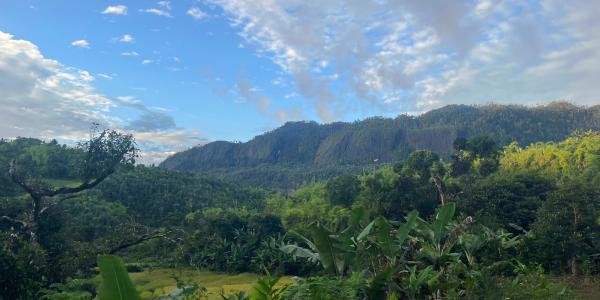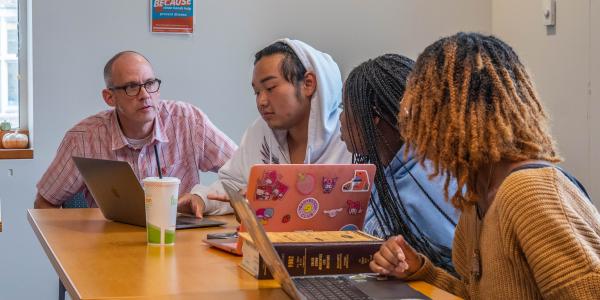Elizabeth Swords’ second year as a Pathfinder Fellow involved lessons on environmental modernism and a 22-day trip to Madagascar, where she conducted a research project in partnership with the Missouri Botanical Garden.
Pathfinder Fellows in Environmental Leadership is a multi-year, interdisciplinary Ampersand Program consisting of 12 students taking an array of courses — both in the field and in the classroom — to build environmental leadership skills. Last year, I wrote about my experiences in the first year of the program, which included a study of Missouri’s natural heritage and an exploration of the interaction between St. Louis’ natural and built environments. In the second year, we began to expand our focus to adopt a global perspective.

Our fall course, taught by senior lecturer Suzanne Loui, explored the concept of environmental modernism, a philosophy that argues humans are capable of improving their standard of living while reducing their environmental impact. I was initially opposed to this concept, but engaging with it made me reevaluate my own perspective, ultimately broadening my understanding of environmentalism and the role of human ingenuity in addressing environmental challenges.
The spring course focused on preparing us for the program’s capstone experience – the research trip to Madagascar. The Missouri Botanical Garden (MBG) has conducted research in Madagascar since the 1970s. A partnership between MBG and WashU allows Pathfinder Fellows to travel to Mahabo, a 10-community commune in southeastern Madagascar, to conduct their own research projects. The course, “Community-Based Conservation,” is co-taught by Froggi VanRiper, lecturer in environmental studies, and Armand Randrianasolo, a lecturer, Missouri Botanical Garden curator, and Mahabo local.
To prepare for our trip, we spent class time planning our projects and learning baseline information such as the ecology of Madagascar, the intersection of poverty and environmental conservation, and the principles of experimental design. My group focused on the cooking strategies employed by rural Malagasy households, intending to explore the feasibility of households transitioning from open-fire stoves to a more fuel-efficient method that can be made from naturally occurring clay in the soil.
At the end of the school year, we were off to Madagascar!

Days 1-4: Arriving and Exploring
On May 9, we flew from St. Louis to Atlanta, then Atlanta to Paris, and finally to Antananarivo, the capital of Madagascar. In total, the journey took about 30 hours.
While recovering from the travel and fighting jet lag from the eight-hour time difference, we explored the city and toured the Rova of Antananarivo, the royal palace that housed Madagascar’s sovereigns during the monarchy.
We also presented our research plans to the MBG office in Antananarivo, which allowed us to receive valuable feedback and suggestions from locals. During this meeting, we met our cultural advisor, an MBG staff member who would accompany us during our project and translate. The cultural advisor for my team, Marina, has been a plant specimen collector with the MBG office for decades and has even had some species named after her!


Days 5-8: Heading to the Forest
The drive from Antananarivo, located in the geographic center of Madagascar, to Mahabo, in the southeast corner, takes about three days. We spent this time refining our research plans and studying Malagasy, the native language of Madagascar. As we traveled, the scenery outside the bus window shifted from dense urban areas, to mountainous landscapes with waterfalls, to the shoreline of the Indian Ocean, and, finally, to the coastal forest where we would spend the next two weeks.


Days 9-17: Working with the Community
Our first day in Mahabo, elders and representatives from surrounding towns traveled to listen to our project plans, which were translated into Malagasy by our cultural advisors. These representatives then relayed this information back to their communities to inform residents of our presence.
In the following days, my team traveled to five of these towns to conduct door-to-door interviews, asking community members about their experiences with their current stoves and their openness to a new design. We were encouraged by the positive response we received — many community members were excited by our improved stove design and eager to build one for themselves! We hosted instructional sessions at the MBG compound, showing locals where to obtain the clay for construction and how to build the stove. Following our demonstrations, the community participants began building their own stoves, improving on our design by adapting the construction process and the dimensions to better meet their needs.
When we were not conducting interviews or hosting stove-building sessions, we visited local markets, played with the local children, explored the surrounding forest, and swam in the ocean.



Days 17-22: Returning Home
Just as the journey to Mahabo had taken five days, so too would the return trip to St. Louis. This travel time offered a chance to reflect on the experiences of the past two weeks. My time in Madagascar was undoubtedly the most remarkable experience of my life. Although I had spent an entire semester studying the country, it took being in Madagascar to begin to truly understand the lifestyle, culture, and environment.
I greatly appreciate the approach this program took in preparing us to engage with the community. The “Community-Based Conservation” course emphasized the importance of centering the community’s needs and expertise throughout every phase of a project. Collaborating with both the MBG staff in Madagascar and local residents allowed us to refine our projects to better address the community’s desires and develop realistic, sustainable solutions.
As I approach my junior year, I am excited to begin the next course in the Pathfinder program, “The Sustainability Exchange.” This initiative pairs students with community clients to tackle real-world challenges in energy, the environment, and sustainability. I look forward to sharing my experiences in these courses next year!

Read about other Ampersand Programs:
A year in the life of a Pathfinder Fellow: A sense of place: The first installment in this series on the Pathfinder Fellows program.
The art and science of cancer care: An inside look at the Hallmarks of Cancer and Patient Care program.
We are all migrants to WashU: Student Gené Nieuwoudt writes about the Safe Asylum program.
Digging into the American dream: Student Conrad Lewis writes about the Examining America program.
Biotech and beyond: Student Gaby Smith writes about the Biotech Explorers Pathway (BEP) program.





